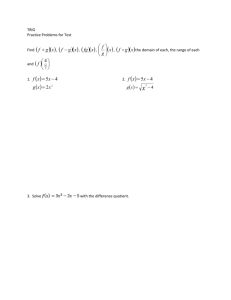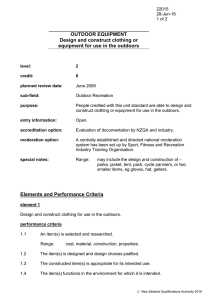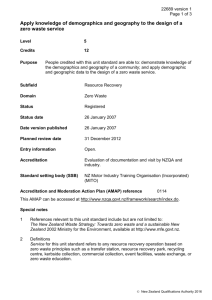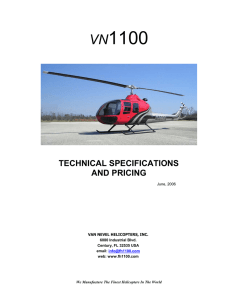OUTDOOR EQUIPMENT Work with helicopters
advertisement
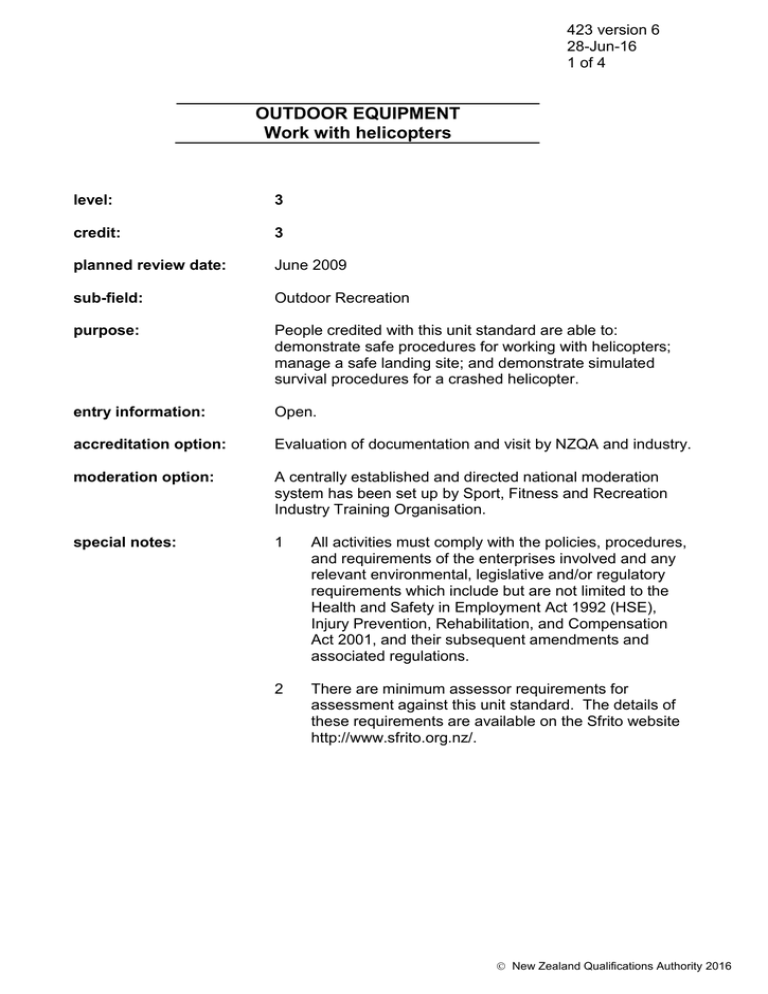
423 version 6 28-Jun-16 1 of 4 OUTDOOR EQUIPMENT Work with helicopters level: 3 credit: 3 planned review date: June 2009 sub-field: Outdoor Recreation purpose: People credited with this unit standard are able to: demonstrate safe procedures for working with helicopters; manage a safe landing site; and demonstrate simulated survival procedures for a crashed helicopter. entry information: Open. accreditation option: Evaluation of documentation and visit by NZQA and industry. moderation option: A centrally established and directed national moderation system has been set up by Sport, Fitness and Recreation Industry Training Organisation. special notes: 1 All activities must comply with the policies, procedures, and requirements of the enterprises involved and any relevant environmental, legislative and/or regulatory requirements which include but are not limited to the Health and Safety in Employment Act 1992 (HSE), Injury Prevention, Rehabilitation, and Compensation Act 2001, and their subsequent amendments and associated regulations. 2 There are minimum assessor requirements for assessment against this unit standard. The details of these requirements are available on the Sfrito website http://www.sfrito.org.nz/. New Zealand Qualifications Authority 2016 423 version 6 28-Jun-16 2 of 4 OUTDOOR EQUIPMENT Work with helicopters Elements and Performance Criteria element 1 Demonstrate safe procedures for working with helicopters. performance criteria 1.1 The instructions of the pilot are followed. Range: 1.2 Procedures to safely approach and leave the operating helicopter are explained and demonstrated. Range: 1.3 pilot eye contact, pilot approval before approaching, hand signals, slope angle, safely managed equipment. An on-site helicopter is loaded and unloaded according to its capabilities and the instructions of the pilot. Range: 1.4 may include but is not limited to – verbal, hand signals, radio communications. compact load, stable load, weight, securing of load, securing of doors, securing of seat belts, storage of equipment; may include but is not limited to – attachment of stropped load, loading of passengers, loading of patients, loading of stretchers. Possible hazards associated with working with secured and hovering helicopters are described and strategies to manage them are explained. Range: hazards may include but are not limited to – smoking, flammable liquids, obscured visibility and down drafts during landing and take-off, rotor blades, flying articles of clothing or other items. New Zealand Qualifications Authority 2016 423 version 6 28-Jun-16 3 of 4 OUTDOOR EQUIPMENT Work with helicopters element 2 Manage a safe landing site. performance criteria 2.1 Methods used to maintain clear communication with the pilot are explained and/or demonstrated. Range: 2.2 A landing site is chosen and the selection justified in terms of safety. Range: 2.3 may include but is not limited to – radio, hand signals, ground marking, flags, pyrotechnics. factors may include but are not limited to – terrain hazards, slope angle, surface roughness, presence of loose material, proximity to buildings, vegetation, overhead cables. Weather conditions that influence landing site choice are identified and their possible effects explained. Range: wind direction and strength, visibility, cloud cover, estimated altitude of cloud ceiling, weather pattern. element 3 Demonstrate simulated survival procedures for a crashed helicopter. performance criteria 3.1 The emergency exits of the helicopter are identified and escape procedures demonstrated. 3.2 Emergency equipment is located and used appropriately. Range: 3.3 may include but is not limited to – survival equipment, axe, fire extinguisher, first aid kit, emergency locator beacons. Emergency procedures on surviving a crash are outlined. Range: clear area, reduce fire risk, attend to injured, communicate with rescue organisations. New Zealand Qualifications Authority 2016 423 version 6 28-Jun-16 4 of 4 OUTDOOR EQUIPMENT Work with helicopters Comments on this unit standard Please contact the Sport, Fitness and Recreation Industry Training Organisation info@sfrito.org.nz if you wish to suggest changes to the content of this unit standard. Please Note Providers must be accredited by the Qualifications Authority or a delegated interinstitutional body before they can register credits from assessment against unit standards or deliver courses of study leading to that assessment. Industry Training Organisations must be accredited by the Qualifications Authority before they can register credits from assessment against unit standards. Accredited providers and Industry Training Organisations assessing against unit standards must engage with the moderation system that applies to those standards. Accreditation requirements and an outline of the moderation system that applies to this standard are outlined in the Accreditation and Moderation Action Plan (AMAP). The AMAP also includes useful information about special requirements for providers wishing to develop education and training programmes, such as minimum qualifications for tutors and assessors, and special resource requirements. This unit standard is covered by AMAP 0050 which can be accessed at http://www.nzqa.govt.nz/site/framework/search.html. New Zealand Qualifications Authority 2016
